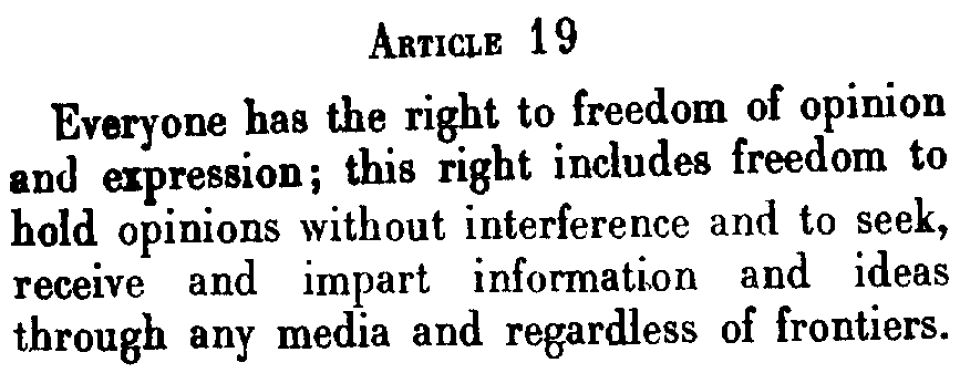
The internet and new technologies provide countless opportunities for women’s empowerment, engagement and education. At the same time, digital tools are increasingly facilitating gender-based threats, harassment, assault and violence against women online. Internet intermediaries have an important role to play in detecting and redressing online violence against women. Yet the response of intermediaries to incidents of gender-based harassment online is too often defined by gendered assumptions and misconceptions about the nature of violence against women online and the tension between addressing online violence and protecting free expression. This series is produced as a part of APC’s End violence: Women’s rights and safety online project and will explore the responsibility of intermediaries to ensure that the internet is a space that empowers, rather than subjugates, women.
Understanding the possibilities and limitations of the right to freedom of expression
The right to freely express oneself is a fundamental prerequisite both of a functioning, vibrant democracy and a free and open internet. Free expression online facilitates public discourse and enables individuals to express ideas, opinions and beliefs, and to challenge the predominant political and social paradigms. For this reason, a free and open internet is a key guarantor of women’s human rights. As the Internet Democracy Project India has observed, “the Internet has enabled women to connect with other women on a range of issues that can benefit the rights of all women, create meaningful relationships outside of the domestic spheres in which many women are confined to offline, and most importantly, find a space to speak and be heard.” [1]
The right to freedom of expression is guaranteed by Article 19 of the International Covenant on Civil and Political Rights. It is not, however, an absolute right; that is, one cannot say and communicate whatever they would like without concern or consideration for the enjoyment of others’ human rights (Article 19(3)). Moreover, one cannot use the veil of free expression to justify language or other forms of expression designed to incite discrimination, hostility or violence (Article 20 (2)).
Violence against women has been recognized by the United Nations as being a manifestation of historically unequal power relations between men and women, and an obstacle to the achievement of equality, development and peace. It therefore follows that incitement to violence against women falls within the exception to freedom of expression, which is otherwise a vitally important right to the promotion of freedom and equality everywhere. According to the UN Declaration on Violence Against Women, it encompasses physical, sexual and psychological violence occurring within the general community, including rape, sexual abuse, sexual harassment and intimidation at work, in educational institutions and elsewhere, trafficking in women and forced prostitution. “In the general community” undoubtedly includes the digital sphere.
Therefore, international human rights law provides for a strong right to free expression that must be tempered by the need to protect against hate speech, or speech that incites violence, including violence against women. However, the existence of exceptions to the right to freedom of expression does not, however, mean that the prohibition against hate speech and incitement to hatred is a straight forward or uncontroversial idea. On the contrary, the exceptions to Article 19 are highly controversial, subjective and prone to manipulation by State entities. This is particularly the case when talking about hate speech on the internet.
Hate speech and free expression on the internet
In facilitating a rapid and interconnected global exchange of ideas, beliefs and opinions, the internet has also acted as a means by which hate speech can be spread with a speed and reach never before witnessed. Twitter, for example, has been embroiled in litigation throughout the year concerning anti-Semitic tweets related to the hashtag #unbonjuif. This map, produced by Humboldt State University, tracks and maps 150,000 instances of hate speech on Twitter over the course of 11 months.
What, then, are the legitimate avenues for redress of hate speech when it occurs on the internet? Whereas many States have now prohibited hate speech in the mainstream media and provided avenues for legal address, including civil, administrative and criminal measures, addressing and redressing hate speech on the internet continues to be a complex process, and one which in many circumstances has opened the door for greater state repression and curtailment of free expression rights. The UN Special Rapporteur for freedom of opinion and expression, Frank La Rue, looked at hate speech on the internet in a 2011 report to the General Assembly, and noted that States have taken steps to implement a number of impermissible restrictions on the right to freedom of expression in the name of curtailing hate speech. These include the blocking or criminalisation of content related to discussion of government policies and political debate, reporting on human rights, government activities and corruption in government; engaging in election campaigns, peaceful demonstrations or political activities, including for peace or democracy; and expression of opinion and dissent, religion or belief, including by persons belonging to minorities or vulnerable groups. Any permissible State initiative to block content must, according to the Special Rapporteur, be content-specific, and must be authorised by an ambiguous law, pursue a legitimate purpose, and respect the principles of necessity and proportionality.
Hate speech on the internet – what role for intermediaries?
Given the contentious nature of restricting free speech on the internet in the name of prohibiting hate speech, there is little consensus as to what the role of internet intermediaries should be in policing such language and behaviour. Should internet intermediaries take a proactive role in scanning for hate speech and other prohibited forms of expression online, and how might this arbitrarily impact upon the enjoyment of freedom of expression? Given that the private sector is driven by financial incentives and is prone to co-option by powerful or even State entities, how might opening the door for a role of internet intermediaries to police content for hate speech might result in the restriction of a free and open internet? Without strong avenues for intermediary accountability and transparency, how can users be sure that speech isn’t being restricted in the name of patrolling for hate speech? How might a push for intermediary liability for the content they host might result in overly risk-adverse intermediaries that err on the side of censorship, rather than internet freedom?
Each of these questions is the subject of fervent debate amongst internet and free expression activists. Our next and final blog in this series will seek to propose a way forward that might mitigate some of these tensions. The starting point, however, must be the promotion of a free and open internet that values a diversity of opinions and tolerance thereof. Intermediaries can take positive steps to promote cross-cultural understanding and the eradication of discriminatory attitudes, particularly those related to the role of women in society. Eradicating hate speech online begings with combating the root problems of bigotry and bias that inform and perpetuate attitudes that oppress and diminish women.
The photo credit Law Inter Alia .
1 Anja Kkovacs, Richa Kaul Padte and Shobha SV, “’Don’t let it stand!’ An exploratory study of women and verbal online abuse in India,” Internet Democracy Project, March 2013.
- 12305 views






Add new comment